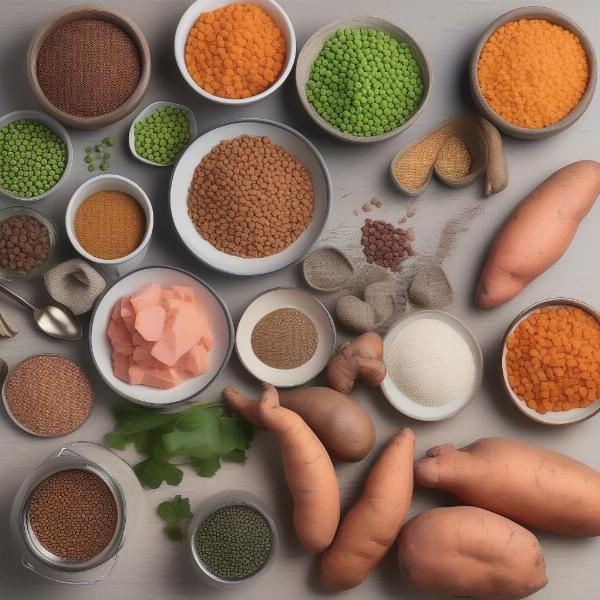Grain-free dog food has become increasingly popular in South Africa and globally. Many pet owners believe it offers numerous health benefits, particularly for dogs with allergies or sensitivities. This guide explores the world of grain-free dog food in South Africa, helping you understand its potential advantages, disadvantages, and how to choose the right option for your furry friend.
Understanding Grain-Free Dog Food
What exactly does “grain-free” mean? Simply put, it refers to dog food that doesn’t contain grains like wheat, corn, rice, barley, or rye. These grains are often used as fillers in cheaper dog foods, providing carbohydrates for energy. Grain-free diets, however, replace these grains with alternative carbohydrate sources like potatoes, sweet potatoes, peas, lentils, or tapioca. This makes them a potential option for dogs with grain allergies or intolerances.
 Grain-Free Dog Food Ingredients
Grain-Free Dog Food Ingredients
Is grain-free dog food always the best choice? Not necessarily. While it can be beneficial for some dogs, it’s not a magic bullet for all canine health issues. Some dogs thrive on grain-inclusive diets, and a sudden switch to grain-free food can upset their digestive system. It’s crucial to consult with your veterinarian before making any significant dietary changes for your dog.
Choosing the Right Grain-Free Dog Food in South Africa
With a growing number of grain-free options on South African shelves, selecting the right one can feel overwhelming. Look for brands that prioritize high-quality animal protein as the primary ingredient. Check the ingredient list for added sugars, artificial colors, flavors, and preservatives, which should be avoided. Prioritize brands that conduct feeding trials and meet AAFCO (Association of American Feed Control Officials) nutritional standards.
Benefits and Potential Risks of Grain-Free Diets
Grain-free dog food can offer several benefits, including improved digestion, healthier skin and coat, increased energy levels, and better weight management, particularly for dogs with grain sensitivities. However, it’s important to be aware of potential risks. In recent years, there have been reports of a potential link between grain-free diets and dilated cardiomyopathy (DCM), a heart condition, in certain breeds. More research is ongoing to fully understand this connection. This underscores the importance of consulting your vet before transitioning your dog to a grain-free diet.
Transitioning to a Grain-Free Diet
If you decide to switch your dog to grain-free food after consulting with your vet, do it gradually. Start by mixing a small amount of the new food with their current food, gradually increasing the proportion of grain-free food over 7-10 days. This helps their digestive system adapt and minimizes the risk of stomach upset.
Is Grain-Free Right for Your Dog?
Ultimately, the decision of whether or not to feed your dog a grain-free diet is a personal one, made in consultation with your veterinarian. Consider your dog’s individual needs, breed, health status, and any existing allergies or sensitivities.
Conclusion
Grain-free dog food in South Africa offers a viable alternative for dogs with grain sensitivities or those who simply seem to thrive on this type of diet. However, choosing the right grain-free food requires careful consideration of ingredients, nutritional value, and potential risks. Always consult with your veterinarian before making any dietary changes, ensuring your dog receives the best nutrition for their individual needs.
FAQ
- Is grain-free dog food suitable for all breeds? Not necessarily. Some breeds may do better on grain-inclusive diets. Consult your vet for personalized advice.
- What are the common signs of grain allergies in dogs? Common signs include itchy skin, skin infections, ear infections, and gastrointestinal issues.
- Are all grain-free dog foods created equal? No. Quality varies significantly. Look for high-quality ingredients and AAFCO-approved brands.
- Can I make my own grain-free dog food? It’s possible, but it’s crucial to ensure nutritional balance. Consult a veterinary nutritionist for guidance.
- How much grain-free food should I feed my dog? Follow the feeding guidelines on the packaging and adjust based on your dog’s age, weight, and activity level.
- What if my dog doesn’t like grain-free food? Try different brands or flavors. You may need to gradually transition them to the new food.
- Where can I buy grain-free dog food in South Africa? It’s available at most pet stores, veterinary clinics, and online retailers.
Related Articles
ILM Dog is your trusted global resource for all things dog-related. We specialize in providing expert advice on dog breeds, health, training, nutrition, grooming, and more. Whether you’re a new dog owner or a seasoned expert, our website provides reliable, practical information to help you care for your canine companion. Contact us for personalized guidance on choosing the right food, training techniques, or any other dog-related concerns. Email: [email protected] Phone: +44 20-3965-8624 Visit ILM Dog for more valuable resources and expert advice.